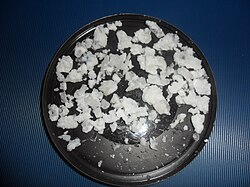Silicic acid
 |
|
| Names | |
|---|---|
|
IUPAC name
Silicic acid
|
|
| Other names
Monosilicic acid
Orthosilicic acid |
|
| Identifiers | |
|
10193-36-9 |
|
| 3D model (Jmol) | Interactive image |
| ChEBI |
CHEBI:26675 |
| ChemSpider |
14236 |
| ECHA InfoCard | 100.109.340 |
| EC Number | 233-477-0 |
| 2009 | |
| PubChem | 14942 |
| UNII |
623B93YABH |
|
|
|
|
| Properties | |
| H4O4Si | |
| Molar mass | 96.11 g·mol−1 |
| Acidity (pKa) | 9.84, 13.2 |
| −42.6·10−6 cm3/mol | |
| Related compounds | |
|
Related compounds
|
Orthocarbonic acid |
|
Except where otherwise noted, data are given for materials in their standard state (at 25 °C [77 °F], 100 kPa).
|
|
|
|
|
| Infobox references | |
Silicic acid /sɪˈlɪsɪk ˌæsɪd/ is a chemical compound. Silicic acid is the general name for a family of chemical compounds containing the element silicon attached to oxide and hydroxyl groups. This family of compounds have the general formula [SiOx(OH)4-2x]n. Some simple silicic acids have been identified, but only in very dilute aqueous solution, such as metasilicic acid (H2SiO3), orthosilicic acid (H4SiO4, pKa1=9.84, pKa2=13.2 at 25 °C), disilicic acid (H2Si2O5), and pyrosilicic acid (H6Si2O7); however in the solid state these probably condense to form polymeric silicic acids of complex structure.
In general, silicic acid reactions are difficult to control. Partial dehydration to metasilicic acid, for example, is challenging because the reaction typically progresses all the way to silicon dioxide and water.
Like other silanols, silicic acid is a weak acid. It can be deprotonated in solution, the conjugate base silicate is known.
Silicic acid was discovered by Jöns Jacob Berzelius between 1810 and 1836 when studying silicon generated by his experiments. However, he failed to recognise it as distinct from silicon dioxide.
...
Wikipedia
